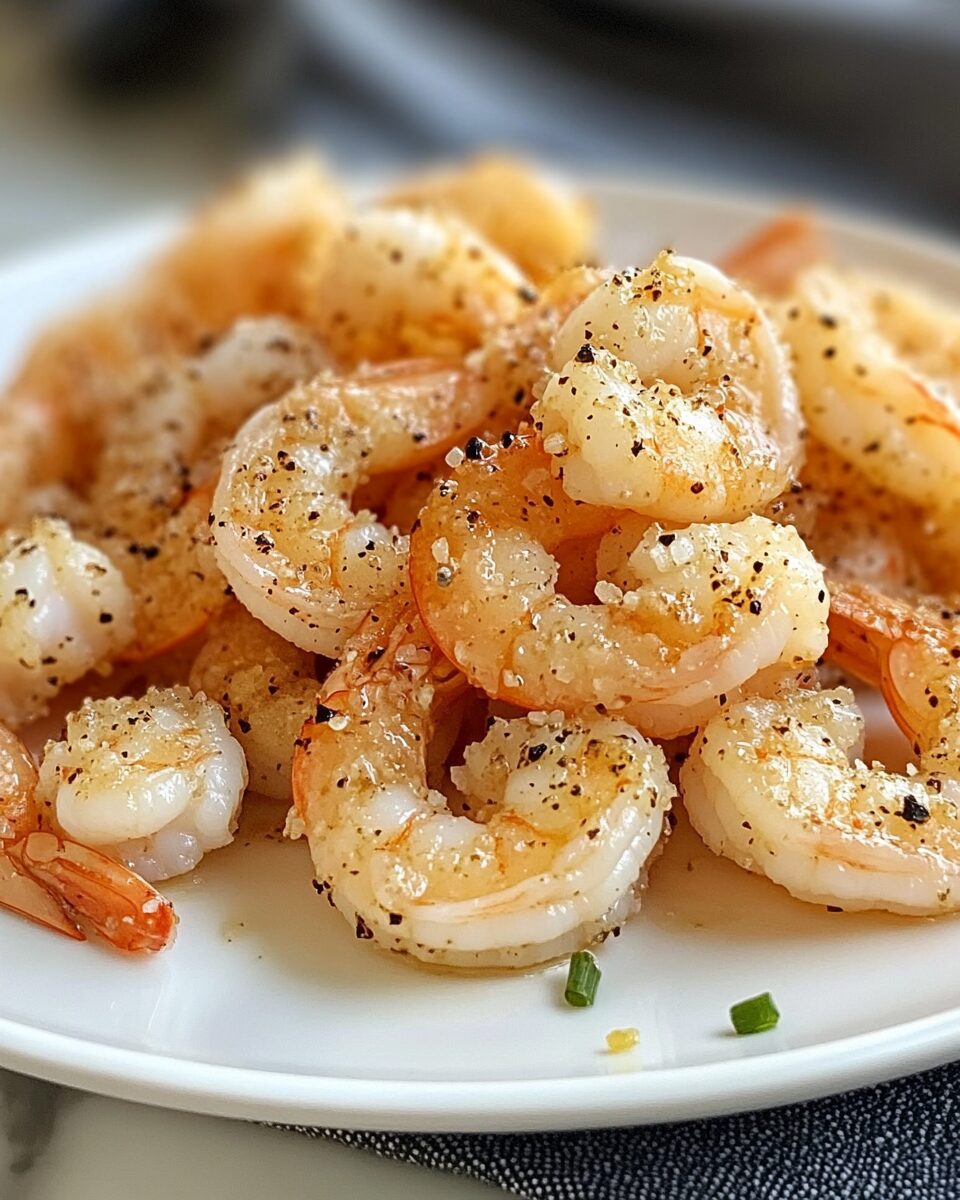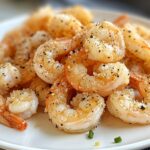The Salt and Pepper Shrimp is a classic Chinese takeout favorite that’s surprisingly easy to whip up at home. This dish is known for its crackly, golden crust and its fragrant coating of garlic, scallions, and just the right amount of heat. The magic is in the balance—crispy shrimp shells, bold aromatics, and that bright finish from a fresh lemon wedge.
Whether you’re planning a quick weeknight dinner or want to impress your guests with something irresistibly savory, this recipe delivers on all fronts. It’s light enough not to weigh you down but packed with flavor to keep you coming back for more. Best served hot and fresh out of the pan, with chilled drinks on the side and good company at the table.
Full Recipe
Ingredients:
-
1 lb large shrimp, shells on, deveined
-
2 tablespoons cornstarch
-
1 teaspoon salt
-
1 teaspoon ground white pepper
-
1 teaspoon Sichuan peppercorns (optional, for extra zing)
-
1 tablespoon vegetable oil
-
3 cloves garlic, finely chopped
-
2 scallions, chopped
-
1 small red chili, thinly sliced (optional)
-
Lemon wedges for serving
Directions:
-
Pat the shrimp dry with paper towels.
-
In a bowl, toss the shrimp with cornstarch, salt, and ground white pepper until evenly coated.
-
Heat oil in a large skillet or wok over medium-high heat.
-
Add the shrimp in a single layer and cook for 2-3 minutes per side until golden and crisp. Remove and set aside.
-
In the same skillet, add a bit more oil if needed, and toss in the garlic, scallions, chili, and Sichuan peppercorns. Stir-fry for 30 seconds until fragrant.
-
Return the shrimp to the skillet and toss to coat in the aromatics.
-
Serve immediately with lemon wedges on the side for an extra burst of freshness.
Prep Time: 10 minutes | Cooking Time: 10 minutes | Total Time: 20 minutes
Kcal: 240 kcal | Servings: 4 servings
Introduction to Salt and Pepper Shrimp
Salt and Pepper Shrimp is a beloved Cantonese dish that has traveled far beyond the borders of southern China, gaining popularity around the world. It’s cherished for its bold flavors, satisfying crunch, and the way it beautifully balances simplicity with a depth of taste. Traditionally made with shell-on shrimp, this dish captures the essence of Asian wok cooking—quick, high-heat stir-frying that locks in flavors while preserving texture and freshness.
In Chinese cuisine, particularly in Cantonese kitchens, this dish is a staple often ordered in seafood restaurants and family gatherings. What makes Salt and Pepper Shrimp so appealing is the minimal use of sauces; instead, it relies heavily on the natural flavor of the shrimp, enhanced by garlic, chilies, and aromatic spices. The result is a dish that is crisp on the outside, juicy on the inside, and full of umami and spice with every bite.
Cultural Background and Origin
Salt and Pepper Shrimp (椒盐虾) originates from the Guangdong province of China, home of Cantonese cuisine. Unlike heavily sauced dishes from other regional Chinese cuisines, Cantonese cooking emphasizes freshness, light seasoning, and letting the ingredients shine. Salt and Pepper Shrimp exemplifies this philosophy by using minimal spices and a quick cooking method that lets the sweetness of the shrimp take center stage.
The dish has evolved over time and adapted to different cultures. In the West, you may find versions with peeled shrimp for ease of eating, while in traditional Chinese settings, shrimp is served shell-on for extra texture and flavor. Whether enjoyed at dim sum, a banquet, or a casual dinner, this dish holds a firm place in both casual and celebratory meals.
Why Salt and Pepper Shrimp is So Popular
What sets Salt and Pepper Shrimp apart is its irresistible combination of textures and flavors. The shrimp is often coated lightly in cornstarch, then quickly deep-fried or pan-fried to a crispy finish. The final toss in sautéed garlic, scallions, and sometimes red chilies makes every bite pungent, peppery, and aromatic.
It’s a dish that comes together quickly, making it ideal for weeknight meals or impromptu entertaining. It also fits a wide variety of diets, being naturally gluten-free and low in carbohydrates when made without flour-based coatings. As more people explore global cuisines and cook at home, Salt and Pepper Shrimp has become a favorite for home cooks looking to replicate restaurant-quality meals.
Another reason for its popularity is versatility. This dish can be paired with steamed rice, noodles, or served as an appetizer with drinks. Its flavor profile is bold but balanced—garlic gives it depth, pepper adds heat, and lemon (or lime) brings brightness. It’s savory, spicy, citrusy, and oh-so-satisfying.
Health and Nutrition Perspective
Shrimp is a lean source of protein that’s low in calories and high in nutrients like selenium, vitamin B12, and iodine. When cooked properly without excessive oil, Salt and Pepper Shrimp can be a healthy and nutritious option. The quick cooking method retains most of the nutrients, and since shrimp cooks so fast, it avoids the long exposure to high heat that can degrade certain vitamins.
Moreover, the use of garlic and chili offers added health benefits. Garlic is known for its antibacterial and heart-healthy properties, while chili peppers can boost metabolism and add antioxidants to your diet. If you’re health-conscious, you can opt to pan-fry rather than deep-fry, use less oil, or even air-fry for a lighter version.
Choosing the Right Shrimp
The quality of the shrimp can make or break this dish. Large shrimp or prawns with the shell on are ideal because the shells add flavor and protect the meat during high-heat cooking. Wild-caught shrimp are often more flavorful, but responsibly farmed shrimp can also be a good option if sourced sustainably.
Make sure to clean the shrimp properly by deveining them, even if you’re keeping the shell on. Patting them dry before coating with cornstarch ensures they fry up crispy rather than steaming in the pan. For those who prefer convenience, peeled and deveined shrimp can be used—just keep in mind you may sacrifice some texture and flavor.
Tips for Perfect Salt and Pepper Shrimp
-
Dry Your Shrimp Thoroughly: Moisture is the enemy of crispiness. Pat shrimp dry with paper towels before tossing with starch.
-
Don’t Overcrowd the Pan: Cooking shrimp in small batches ensures they fry up golden and crispy instead of steaming.
-
Use High Heat: Wok cooking requires high temperatures to quickly sear the shrimp and aromatics without overcooking.
-
Add Aromatics at the End: Garlic, scallions, and chili should be quickly stir-fried after the shrimp are done to prevent burning and to maintain their punchy aroma.
-
Serve Immediately: This dish is best when hot, straight from the pan, with a fresh squeeze of lemon or lime.
Serving Suggestions
Salt and Pepper Shrimp is incredibly versatile when it comes to serving. Traditionally, it’s placed in the center of a table as part of a shared meal with other stir-fries, vegetables, and soups. At home, it can easily stand alone as a main dish.
Pair it with:
-
Steamed jasmine or sticky rice
-
Garlic noodles or stir-fried greens
-
A light cucumber salad to cool down the spice
-
Cold beer, white wine, or iced tea for a refreshing contrast
Because of its bold, umami-packed flavors, this dish doesn’t require complicated sides. Simplicity is key to letting the shrimp be the star.
Common Variations
While the classic version is relatively simple, there are several popular variations to explore:
-
Five-Spice Salt and Pepper Shrimp: Adds Chinese five-spice powder for a deeper aroma.
-
Butter Salt and Pepper Shrimp: Uses a knob of butter for richness.
-
Salt and Pepper Squid or Tofu: The seasoning technique can be applied to other proteins.
-
Chili-Garlic Shrimp: For those who crave more heat and pungency.
This flexibility makes it easy to adapt to different dietary needs and preferences.
How to Store and Reheat
Salt and Pepper Shrimp is best eaten fresh, but leftovers can be stored in an airtight container in the fridge for up to two days. To reheat, place the shrimp in a hot skillet or air fryer to bring back some of the crispiness. Avoid microwaving, as it tends to make the shrimp rubbery and soggy.
Conclusion
Salt and Pepper Shrimp is more than just a quick and tasty seafood dish—it’s a celebration of Cantonese culinary wisdom, where restraint and technique transform a few simple ingredients into something extraordinary. The interplay of salty, spicy, garlicky flavors with the natural sweetness of the shrimp creates a dish that’s comforting, exciting, and endlessly craveable.
Whether you’re recreating a dish you loved at your favorite Chinese restaurant or trying something new at home, this recipe invites you into a world of flavor with very little effort. With its minimal prep and maximum satisfaction, Salt and Pepper Shrimp deserves a permanent spot in your weeknight dinner rotation—or your next dinner party menu.
The next time you’re looking for a dish that’s fast, flavor-packed, and sure to impress, Salt and Pepper Shrimp is the one. It’s quick to make, gorgeous on the plate, and full of character with every bite.






